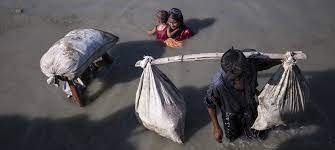By Madara Dias, MHR Program, University of Manitoba
Date: May 22, 2025
As Myanmar teeters on the edge of a humanitarian and political abyss, one thing has become painfully clear that the traditional peace processes are deteriorating. The webinar hosted by the Conflict and Resilience Research Institute Canada (CRRIC) on Charting a lasting peace in Myanmar; ending Decades- Long Armed Conflict, offered a sobering yet enlightening insight into the ongoing crisis and the multidimensional strategies needed to forge a path toward peace.
The effort isn’t just about ending war. It’s about rebuilding a broken nation which is ethnically diverse, politically fragmented, and humanly devastated.
A Brief Overview on Myanmar Conflict
Myanmar’s conflict is a deeply rooted, multifaceted crisis shaped by ethnic tensions, authoritarian rule, and decades of civil war. Since gaining independence from Britain in 1948, the country has struggled with internal division and militarization. The military, or Tatmadaw, has dominated politics for most of its post-independence history, often suppressing democratic movements and ethnic minorities.
In 2017, global attention turned sharply to Myanmar when the military launched a brutal campaign against the Rohingya Muslim minority, leading to accusations of genocide and the displacement of over 700,000 people to Bangladesh.
The situation deteriorated further after the 2021 military coup, which overthrew the elected civilian government led by Aung San Suu Kyi. The coup triggered nationwide protests and the rise of new resistance forces, including the People’s Defense Forces (PDFs) and the National Unity Government (NUG), which now collaborate with long-standing ethnic armed groups.
The Complexity of Myanmar’s Conflict
Myanmar’s decades-long strife is not merely a civil war, but a conflict shaped by overlapping sovereignties, ethnic exclusion, military authoritarianism, and now, widespread resistance by both minority groups and the Bama majority.
With 135 officially recognized ethnic communities, many of which have their own armies, governance structures, and even currencies as Myanmar is not a classical Westphalian state. Instead, it’s a patchwork of fragmented sovereignties competing for recognition, survival, and justice.
The Humanitarian Catastrophe and Rebuilding A New Peace Paradigm
The human cost is staggering over a million Rohingya displaced, many languishing in precarious conditions in Bangladesh. An earthquake has recently exacerbated the already dire situation in Rakhine state, destroying infrastructure and deepening suffering.
Despite calls for humanitarian corridors, the political will and legal mechanisms remain weak. The United Nations has yet to adopt formal resolutions to enforce such access, and local agreements are often hindered by mistrust and contested sovereignty.
Speakers emphasized that peace cannot be reduced to ceasefires. A sustainable resolution requires a Marshall Plan-style reconstruction not just of buildings, but of institutions, trust, and national identity. Dr. Imtiaz Ahmed, Professor and Executive Director, Center for Alternatives has pointed that restoring infrastructure, and public services should be included in the model while promoting justice and accountability. Further, ensuring safe, voluntary repatriation of displaced communities like the Rohingya has been identified as mandatory requirement in urging to build inclusive governance systems from the grassroots.
This discussion revealed that, the track One diplomacy, state-to-state negotiations is proving insufficient. Many resistance groups, especially those with momentum, refuse to engage with the military. That’s why Track Two and Track Three engagements are vital. Track two, particularly dealing with involving academics, think tanks, and regional partners in informal diplomacy. Empowering community leaders, youth, and women to voice their needs and solutions also necessary as the track three diplomacy. It is important to conduct simulation-based Dialogue, specially involving the tools like smart Settle, inspired by Gaza peace efforts, could help stakeholders explore scenarios in a low-risk, collaborative setting.
The Regional and Global Picture on conflict and how Rohingya can viewed as Political Stakeholders
The role of international actors is complex and evolving in this context. ASEAN, specially under Malaysia’s leadership, is shifting from a passive stance to advocating for practical, multilateral humanitarian access. China also continues to act primarily in regions tied to its investments, brokering selective ceasefires for strategic gain. The United States appears to be recalibrating its foreign policy, with uncertainty surrounding legislative efforts like the Burma Act. Further, Canada has potential to contribute meaningfully, but only if it supports efforts that prioritize the voices and safety of Myanmar’s people.
Too often viewed solely as aid recipients, the Rohingya must be recognized as political actors. While there have been important steps like the NUG using the term “Rohingya” and pledging legal recognition as the systemic discrimination persists. Efforts must go beyond repatriation. The goal is inclusive citizenship reform, empowerment of civil society within refugee camps, and the emergence of trusted leadership, even if it exists underground due to security concerns.
The Way Forward: A Shared Responsibility
In the face of military oppression, Myanmar’s civil society has composed of educators, health workers, students, and everyday citizens who has become the backbone of resistance. They are not merely protesting, but governing, educating, and building alternative systems of justice and service delivery. Their involvement is not optional but has to be in central to any peacebuilding effort.
Myanmar’s crisis is not intractable. But solving it demands a fundamental shift from reactive policies to proactive, inclusive, and innovative peacebuilding. It’s not just about negotiating with generals. It’s about listening to teachers, farmers, youth leaders, and refugees. As Advocates for the peace, we must see investing in Myanmar not simply as a way to stop the war, but as a path to uniting the country and building a peaceful, inclusive nation.
Join the Conversation through the link- https://www.youtube.com/watch?v=w2uNI6RVdHA&t=17s
Leave your thoughts in the comments or share this article to continue the dialogue.



